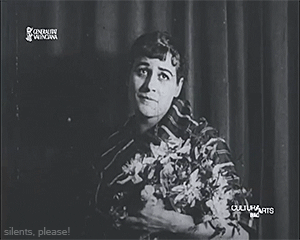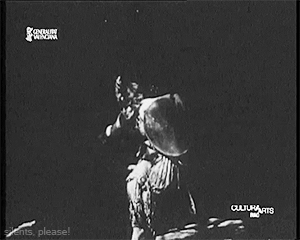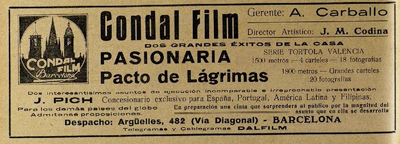From the Spain of a century ago comes the extraordinary film Pasionaria. The film is a star vehicle for Carmen Tórtola Valencia, better known simply as Tórtola Valencia, a famous Spanish dancer of the era who specialized in exotic dances. Here she is in her introduction to the film:
Before I came across this film, I had never heard of the talented and provocative Tórtola Valencia. Her entry in The Feminist Encyclopedia of Spanish Literature, written by Carlota Caulfield, describes her as “one of Spain’s most controversial women” and indeed she seems ahead of her time in many ways: an avant-garde dancer who spoke many languages; a feminist and a vegetarian; a fiercely independent women who never married and whose life partner (whether romantic or not, we do not know) was a woman.
One doesn’t hear much about Spanish cinema of the silent era, save for the seminal figure of Segundo de Chomón, more famed for his work in France and Italy, and Buñuel and Dalí’s Un Chien Andalou, which was a French production. As in other European countries, the new medium of moving pictures quickly became very popular; Joan M. Minguet writes that in 1911, Barcelona had an impressive 139 cinemas for a population of 500K. However, the market was dominated by imports; Pathé and Gaumont set up shop in Spain early on, and it follows that French exports would have been common on Spanish screens. From periodicals of the time, it’s clear that Italy and the US were also key film suppliers. According to Minguet, while there was always a local film-making industry, Spain lacked the necessary infrastructure to support consistent local production, and few companies had a long shelf-life; in turn, this lack of reliability deterred theatres from showing Spanish productions. As in many countries, film was considered controversial and challenged by the religious authorities, but in the period 1910-15, cinema gained greater cultural legitimacy in Spain. As Tórtola Valencia was a major dance star at the time of Pasionaria, the film could be considered part of that trend towards greater status for cinema.
A shortish feature film (surviving running time: 24:37), Pasionaria is “An episode of cruel life: the passion of grief, and the revenge of a woman overwhelmed by a tragic fate” (Un episodio de la vida cruel, la pasión de dolor y de desquite de una mujer abrumada por un destino trágico). Tórtola Valencia’s character Adriana is in love with her boyfriend Angel Montes, but must cope with the failing health of her mother. Visiting her one evening and hearing the grim prognosis of the doctor, Adriana volunteers to go to the pharmacy to gain necessary supplies. Nearby, the sinister Marqués del Olmo and his friends have been drinking. On the street, they harrass her; no shrinking violet, Adriana defiantly shoves them away from her. However, as an intertitle tells us, the drink, her beauty, and her overt resistance have “ignited an overwhelming passion” in the Marqués (a encender en el Marqués una pasión avasalladora). Colluding with the madam, the men drag her back to a brothel where they rape her.
Next we see Adriana’s father at the home of the Marqués, who tells the former that she prostituted herself to them: “times are hard! … But I am a gallant man, and if you need more money …” (los tiempos son tan duros! … Pero yo soy un hombre galante y si le hace falta más dinero …”) Adriana’s father accepts the authorative words and manner of the Marqués, and is horrified: out of shame, he casts Adriana out.
It is at the home of her old dance teacher that Adriana finds solace. Some months later, now a genuine artist, we see her leave Spain for the distant shores of America. Cut to five years later: under the name of Tórtola Valencia, Adriana has become a famous dancer, mesmerizing audiences with her “royal, unique art” (fascina a los públicos con su arte soberano, único). (Side note: this mirrors the real-life career trajectory of Tórtola Valencia, who made her name abroad before débuting in Spain). Adriana eventually plans to return to Spain with her beloved child; she writes to Angel Montes to inform him. Angel, who still loves her deeply, persuades Adriana’s father to forgive her for having a child out of wedlock (ugh), and the end of the film sees the family reunited in forgiveness.
Joan Maria Codina directed Pasionaria capably but without particular flair. He is economical – here, framing and staging make a virtue of a rather basic set:
And a simple but striking shot depicting Adriana’s departure for America:
It will be apparent from the above GIFs and screenshots above that Pasionaria survives in quite poor condition; fragmentary, scratched, high-contrast and often with blown-out highlights/ shadows (presumably the surviving material is not a first-gen print), and in parts suffering from quite severe nitrate damage. Here is a film where the patina of time is visible. Given the small number of prints that would have been made of this title, it seems something of a miracle that it survives at all; consider how many films starring big Hollywood names are lost. While it would obviously be ideal for there to be a pristine copy available, there is a certain allure to this visibility of the passing years – time inscribed on celluloid. (I’m admittedly biased here – there’s a reason I’ve watched Decasia so many times …) Sometimes the nitrate damage is striking both visually and in the way in which it interacts with the content, as in this shot of the Marqués’ party.
Elsewhere, actual fingerprints are visible on the film surface.
The real attraction is, of course, Tórtola Valencia, and the extended dance scene included in Pasionaria. Unfortunately, this scene is the most fragmentary part of the film, and also shows severe decomposition. Only one frame in several is extant, making for a discontinuous, slideshow-like effect – I am not sure whether only certain frames could be included due to severe damage or whether these are actually all the available frames, but I think it is the latter. Here is part of this fragmentary dance scene recreated in GIF form:
At other points in the dance, fewer frames are missing, although they are still presented at the same slowed-down speed as above. (In fact, the timing of the video clip is imperfect in general, though I suspect some of that is down to variations in speed in the original film, or missing frames … the animated gifs I’ve made represent the speed of the video pretty accurately, but some look more naturalistic than others). Anyway, here is some of the later dance footage, sped up from how it appears in the video to approximate a more life-like speed:
Just gorgeous. As you can see, the nitrate damage is particularly severe in this section of the film, but there is a kind of poetry and beauty in its appearance too; am I being overly romantic in thinking that it somehow complements the expressiveness and exoticism of her dance? It is easy, too, to see the appeal of Tórtola Valencia, whose charisma comes through on screen, elsewhere in the film as well as here in her dance performance. For me, this kind of film is just fascinating. As a piece of storytelling, it is unexceptional, but as a document of dance and the only surviving footage of a fascinating woman, it’s wonderful to be able to see, calling out across the years.
Stray thoughts:
- The opening titles state that Pasionaria is the first in a series of films – it is unclear to me whether this refers specifically to films starring Tórtola Valencia, or simply a production series by Condal-Film. In any case, Tórtola Valencia only made one other film, Pacto de lágrimas | Pact of Tears (1915), which is regrettably not extant.
- Although the film is incomplete (only the first and last part survive, plus fragments of the dance scenes), the plot seems relatively intact; the dance scenes have suffered the most. That said, the fact that Adriana had a child as the result of her rape is glossed over in the available version, so perhaps that was more established in now-missing footage. I also noticed an intertitle or two out of place (a title card announces “Third Part” at the beginning of the second part, for example).
- The director Joan Maria Codina is not female, as non-Spanish speakers might think at first. Joan is the Spanish analogue for John/Johannes/Juan/etc – think of Joan Miró – and Maria was a common middle name for men in Catholic countries (in fact, my father has it as a middle name too).
- Just as a point of interest: tórtola means turtledove in English.
- Blooper reel: at the left, note the guy step into shot, realize that he isn’t meant to be there, and step back inside.
Publicity material
Pasionaria premiered in Barcelona on 04 September 1915 at the Teatro Sala Imperio, especially scored by the Orquesta del Sindicato Musical 2. In the days prior, the premiere was publicized in newspaper La Vanguardia:
Several days after the première, the film moved to the Diana-Royal-Argentina cinema and then the Empresa Bohemia; on the 11th and 12th, Pasionaria was showing at the Salón Cataluña – the notice mentions the “fire dance” (la DANZA DEL FUEGO) that she performs in the film. On the 19th & 20th of September, Pasionaria was showing at the Cinema Gráfico. (Incidentally, a title heavily advertised on these last dates was Diana la fascinadora, a.k.a. Bertini’s Diana l’affascinatrice). This progression generally follows the order in which cinemas were listed in La Vanguardia, presumably going from most to least prestigious.
FilmoTeca de Catalunya have digitized and OCR’d large runs of vintage Spanish cinema periodicals, in which one can find some adverts for the Tórtola Valencia films. In the July editions of El mundo cinematográfico, there are full-page adverts for Pasionaria:
As well as other adverts more emphasizing the work of the production company Condal Film.
The length of Pasionaria is reported at both 1400m and 1500m, most commonly the latter.
Via the excellent Hemeroteca Digital newspaper service of the National Library of Spain, it’s possible to find several mentions of Tórtola Valencia’s films in Madrid newspapers. Interestingly, despite Juan Pich’s name being listed as exclusive distributor in the adverts above, an article in El Mentidero of 04 September 1915 quotes a letter from Condal Film head Señor D. A. [Arturo] Carballo, who has written in to state that contrary to announcements by Juan Pich (like this one in El Cine), Condal Film holds the exclusive rights to distribute the Tórtola Valencia films. One wonders what the situation was there …
Aside from its mention in the adverts above, we can also see cinema listings for Tórtola Valencia’s other film Pacto de lágrimas, which at 1750m or 1800m was of slightly longer duration than Pasionaria. From the Madrid papers, we can see that Pacto de lágrimas played at the theatre Royalty y Principe Alfonso on 10 March 1916, alongside Chaplin’s The Star Boarder (Charlot pensionista, US 1914) and the fourth episode of Los misterios de Nuevo York (a.k.a Les mystères de New York, a combination of three Pearl White serials recut into a new 22-episode serial for French release). The next night, Pacto de lágrimas was screening at the Trianon Palace, again with episodes of Los misterios de Nuevo York on the bill; on the 16th and 17th of March, Pacto de lágrimas was playing at the Cinema España.
– – –
Tórtola Valencia – a fascinating woman mostly forgotten today. Hopefully, this article makes her a little more visible.
– – –
Pasionaria. Dir. Joan Maria Codina. Barcelona, Spain: Condal Films, 1915. Pasionaria is preserved by IVAC (Instituto Valenciano del Audiovisual y de la Cinematografía), the Filmoteca which is administered by the government of the autonomous region of Valencia. It is available to view on Vimeo here.

























Pingback: Announcement: Hollywood’s Hispanic Heritage Blogathon 2015 | Once upon a screen…
Pingback: ¡De Película! Hollywood’s Hispanic Heritage Blogathon | Once upon a screen…
A fascinating and enlightening post, thank you!
LikeLike
Thank you for reading!
LikeLike
Tórtola Valencia sounds wonderful. What a pity – as always – she isn’t better known, but thanks for showing her some love. From what I’ve read (limited) she had many strings to her bow: costume designer, painter… she doesn’t fit under one label, like so many stars of the era.
I’ve actually been on the lookout for The Feminist Encyclopedia of Spanish Literature for a while but it’s almost impossible to find (for a reasonable price) in the UK.
LikeLike
Thank you for the comment, V. :) Tórtola Valencia was certainly a multi-talent! I really became fascinated with her after coming across this film, so this was my modest attempt to raise her filmic profile.
Heh, I doubt there are many copies of that book floating around New Zealand either. Thank goodness for the library.
LikeLike
I’m with you: while I wish that nitrate damage didn’t exist, there’s something about seeing films in their state of decay that is moving. It makes me instantly aware of life and death and decay and what’s-my-place-in-the-universe and all that. Thanks for a wonderful post about a forgotten woman.
LikeLike
Thank you for reading! And yes, there is something mesmerizing and beautiful about nitrate decay.
LikeLike
Pingback: Pasionaria (1915) | Frank T. Zumbachs Mysterious World